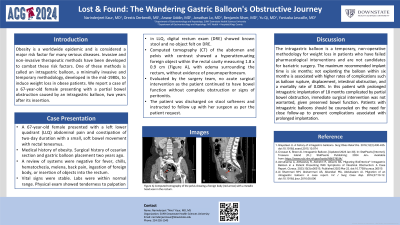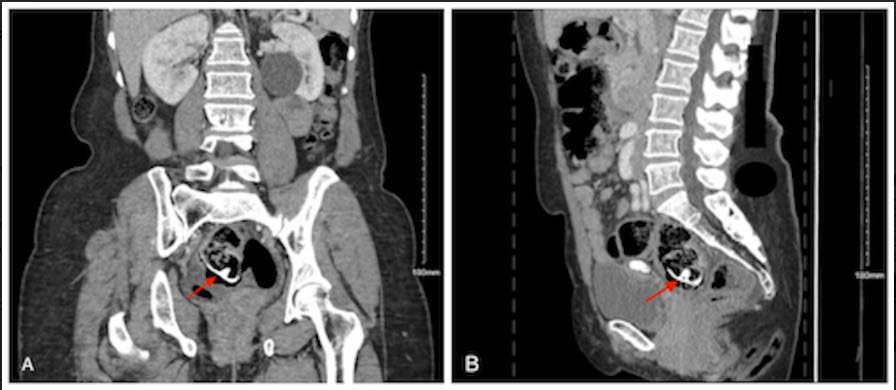Sunday Poster Session
Category: Interventional Endoscopy
P1123 - Lost and Found: The Wandering Intragastric Balloon's Obstructive Journey
Sunday, October 27, 2024
3:30 PM - 7:00 PM ET
Location: Exhibit Hall E

Has Audio
.jpg)
Narinderjeet Kaur, MD, MS
SUNY Downstate Medical Center
Brooklyn, NY
Presenting Author(s)
Narinderjeet Kaur, MD, MS1, Orestis Derbentli, BA2, Jonathan Lo, MD1, Anwar Uddin, MD1, Benjamin Silver, MD1, Yaniuska Lescaille, MD, MPH1, Qi Yu, MD, MPH1
1SUNY Downstate Medical Center, Brooklyn, NY; 2Caribbean Medical School, Chicago, IL
Introduction: Obesity is a worldwide epidemic and is considered a major risk factor for many serious diseases. Invasive and non-invasive therapeutic methods have been developed to combat these risk factors. One of these methods is called an intragastric balloon, a minimally invasive and temporary methodology, developed in the mid-1980s, to induce weight loss in obese patients. Reported here is a patient who presented with a partial bowel obstruction caused by an intragastric balloon two years after its insertion.
Case Description/Methods: A 67-year-old female with the comorbidity of obesity presented to the hospital with left lower quadrant (LLQ) abdominal pain and constipation of two-day duration. She reported small, soft bowel movements with rectal tenesmus. Her surgical history included a Cesarean section and gastric balloon placement. Review of systems were negative for fever, chills, hematochezia, melena, back pain, ingestion of foreign body, or insertion of objects into the rectum. Vital signs and labs were within normal ranges. Physical exam showed tenderness to palpation in LLQ and digital rectal exam (DRE) showed brown stool with no foreign objects palpated. Computed tomography (CT) of the abdomen and pelvis with contrast showed a hyperattenuating foreign object within the rectal cavity measuring 1.8 x 0.9 cm (Figure 1), with edema surrounding the rectum, without evidence of pneumoperitoneum. The patient had a surgical evaluation, and no surgical intervention was recommended given uninterrupted bowel function without complete obstruction or signs of peritonitis. The patient was discharged on stool softeners and instructed to follow up in the hospital in 2 days or with her surgeon.
Discussion: The intragastric balloon is a temporary, minimally invasive methodology for weight loss in patients who have failed pharmacological interventions and are not candidates for bariatric surgery. The maximum recommended implant time is 6 months; not explanting the balloon within 6 months is associated with higher rates of complications such as balloon rupture, displacement, intestinal obstruction, and a mortality rate of 0.08%. In this patient with prolonged intragastric implantation of 24 months complicated by a partial bowel obstruction, immediate surgical intervention was not warranted given preserved bowel function. Patients with intragastric balloons should be counseled on the need for close follow-up to prevent complications associated with prolonged implantation.

Disclosures:
Narinderjeet Kaur, MD, MS1, Orestis Derbentli, BA2, Jonathan Lo, MD1, Anwar Uddin, MD1, Benjamin Silver, MD1, Yaniuska Lescaille, MD, MPH1, Qi Yu, MD, MPH1. P1123 - Lost and Found: The Wandering Intragastric Balloon's Obstructive Journey, ACG 2024 Annual Scientific Meeting Abstracts. Philadelphia, PA: American College of Gastroenterology.
1SUNY Downstate Medical Center, Brooklyn, NY; 2Caribbean Medical School, Chicago, IL
Introduction: Obesity is a worldwide epidemic and is considered a major risk factor for many serious diseases. Invasive and non-invasive therapeutic methods have been developed to combat these risk factors. One of these methods is called an intragastric balloon, a minimally invasive and temporary methodology, developed in the mid-1980s, to induce weight loss in obese patients. Reported here is a patient who presented with a partial bowel obstruction caused by an intragastric balloon two years after its insertion.
Case Description/Methods: A 67-year-old female with the comorbidity of obesity presented to the hospital with left lower quadrant (LLQ) abdominal pain and constipation of two-day duration. She reported small, soft bowel movements with rectal tenesmus. Her surgical history included a Cesarean section and gastric balloon placement. Review of systems were negative for fever, chills, hematochezia, melena, back pain, ingestion of foreign body, or insertion of objects into the rectum. Vital signs and labs were within normal ranges. Physical exam showed tenderness to palpation in LLQ and digital rectal exam (DRE) showed brown stool with no foreign objects palpated. Computed tomography (CT) of the abdomen and pelvis with contrast showed a hyperattenuating foreign object within the rectal cavity measuring 1.8 x 0.9 cm (Figure 1), with edema surrounding the rectum, without evidence of pneumoperitoneum. The patient had a surgical evaluation, and no surgical intervention was recommended given uninterrupted bowel function without complete obstruction or signs of peritonitis. The patient was discharged on stool softeners and instructed to follow up in the hospital in 2 days or with her surgeon.
Discussion: The intragastric balloon is a temporary, minimally invasive methodology for weight loss in patients who have failed pharmacological interventions and are not candidates for bariatric surgery. The maximum recommended implant time is 6 months; not explanting the balloon within 6 months is associated with higher rates of complications such as balloon rupture, displacement, intestinal obstruction, and a mortality rate of 0.08%. In this patient with prolonged intragastric implantation of 24 months complicated by a partial bowel obstruction, immediate surgical intervention was not warranted given preserved bowel function. Patients with intragastric balloons should be counseled on the need for close follow-up to prevent complications associated with prolonged implantation.

Figure: Figure 1) Computed tomography of the pelvis showing a foreign body with a metallic head seen in the rectum (red arrow).
Disclosures:
Narinderjeet Kaur indicated no relevant financial relationships.
Orestis Derbentli indicated no relevant financial relationships.
Jonathan Lo indicated no relevant financial relationships.
Anwar Uddin indicated no relevant financial relationships.
Benjamin Silver indicated no relevant financial relationships.
Yaniuska Lescaille indicated no relevant financial relationships.
Qi Yu indicated no relevant financial relationships.
Narinderjeet Kaur, MD, MS1, Orestis Derbentli, BA2, Jonathan Lo, MD1, Anwar Uddin, MD1, Benjamin Silver, MD1, Yaniuska Lescaille, MD, MPH1, Qi Yu, MD, MPH1. P1123 - Lost and Found: The Wandering Intragastric Balloon's Obstructive Journey, ACG 2024 Annual Scientific Meeting Abstracts. Philadelphia, PA: American College of Gastroenterology.
